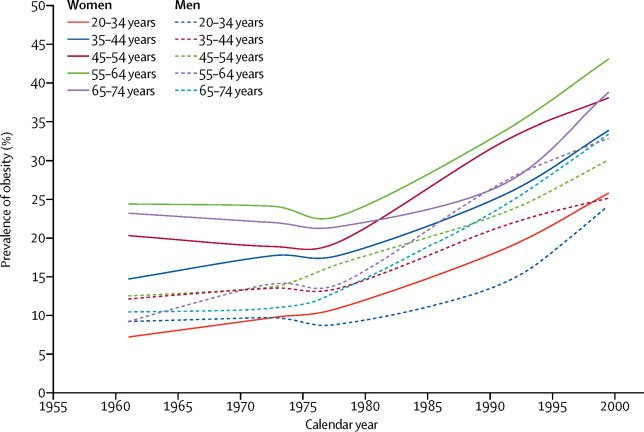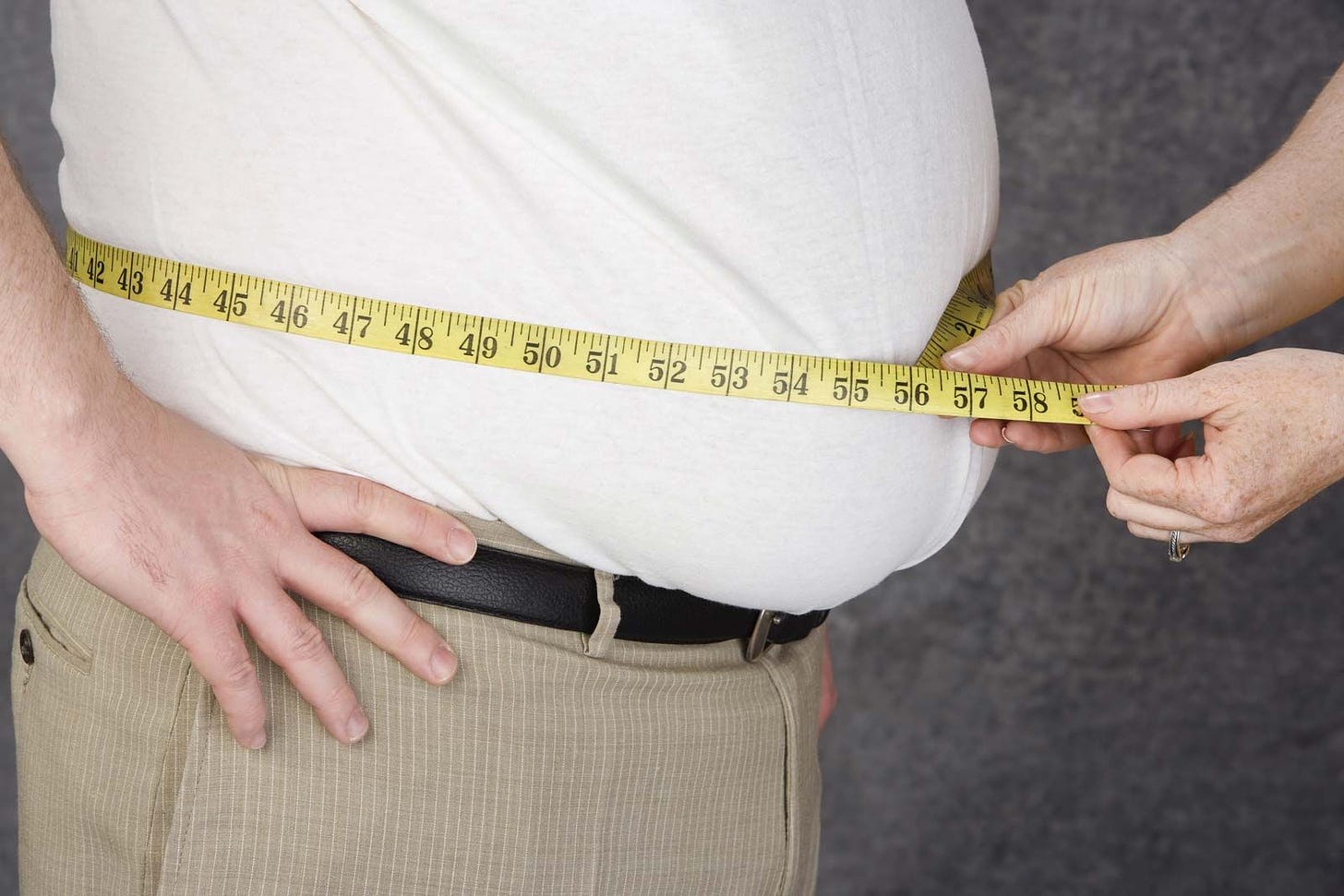Bodyweight and its impact on health have undergone a significant transformation over the decades. From the lean and active populations of the 1950s-70s, to the modern obese and unhealthy versions, the evolution of bodyweight reflects a fascinating account of diverse influences on human health.
We are currently facing a nationwide obesity crisis as North Americans continue to gain weight. Approximately 65% of adults and 15% of children and adolescents are classified as overweight or obese.
The physiological mechanism causing this increase are manifold, and I’ll discuss them here to give you a better understanding of our changing times.
From the 1960’s to Now
The Atlantic writes:
“A study published recently in the journal Obesity Research & Clinical Practice found that it’s harder for adults today to maintain the same weight as those 20 to 30 years ago did, even at the same levels of food intake and exercise.”
The increases in the prevalence of obesity began in the late 1970s across the entire North American population. The speed and extent of weight gain varied somewhat by age, sex and ethnicity, but for all subgroups most people became heavier at about the same time. So either all people had a simultaneous decline in willpower, or something else “snuck” into the picture.”
Let’s look at an old “crowd shot” from a few decades ago. What do you notice right away? Overweight people are largely absent.
Why is that?

Back then, most people ate healthy whole foods and junk food were largely off the table except as a treat. Today 80% of the public goes along with mainstream health recommendations (more carbohydrates, less fats, dairy, etc) and get more sick each year.
Twitter user Brian Sanders says this:
How were people effortlessly thin in the 1950s, 60s, and 70s?
– They didn’t do crazy diets, count calories or fast
– They didn’t have gym memberships… and they even ate dessert
It’s all about portion control.
– They ate food cooked from scratch, animal protein and full fat
– They ate out only as a treat
– They didn’t eat foods w/long ingredient lists… so they were properly satiated by their foods. They naturally ate the right amount long term.
And then the 80s came along, and that’s when everything started to change. You'll note from the graph that 1976 was more or less the inflection point.
What happened? The US dietary guidelines got introduced, low-fat products became a thing, there were huge increase in seed oil, refined grains, and added sugar, chemicals and fillers displacing real foods, and people started eating out as a normal pastime.
The light begins to dawn when you look at nutrition figures in more detail. Today, we buy half as much fresh milk per person, and more pop and ice cream. We buy half as many eggs as in 1976, but a third more breakfast cereals and twice the cereal snacks; half the total potatoes, but three times the crisps. While our direct purchases of sugar have sharply declined, the sugar we consume in drinks and confectionery has rocketed. In other words, the opportunities to load our food with sugars have boomed.
Source: Boingboing.net
There are more reasons, or course:
Chemicals: People are exposed to more chemicals that might be weight-gain inducing. Pesticides, flame retardants, and the substances in food packaging might be altering our hormonal processes and tweaking the way our bodies put on and maintain weight.
Prescription Drugs: The use of prescription drugs has also risen dramatically since the 1970s and ’80s. Prozac, the first blockbuster SSRI, came out in 1988. Antidepressants are now one of the most commonly prescribed drugs in the U.S., and many of them have been linked to weight gain.
Unhealthy Guts: The microbiomes of Americans have likely changed between the 1980s and now. It’s well known that some types of gut bacteria make a person more prone to weight gain and obesity. Many animal products are treated with hormones and antibiotics in order to promote growth. All that meat might be changing gut bacteria in radical ways. The proliferation of artificial sweeteners could also be playing a role.
Source: The Atlantic
Food Marketing: Scientists working for food companies are tasked with creating heavily processed, calorie dense products that are increasingly irresistible, while advertising companies use psychologists and neuroscientists to dismantle our defenses and willpower.
Portion Sizes: The average serving sizes of restaurant meals, fast food chains, have increased substantially over the decades. Restaurants offer oversized portions and fast food chains have introduced super-sized options (or value meals) at low cost to wallet, but high cost to health.
Eating Out: The shift towards busier lifestyles, longer working hours, and dual-income households has led to a greater reliance on convenient and quick (yet extremely unhealthy) meal options outside the home.
Food Delivery Services: The emergence of food delivery platforms and services (sucha s Uber Eats, DoorDash, Grubhub, Postmates, and Deliveroo) has made it easier for consumers to order restaurant meals and have them delivered to their homes, increasing convenience of ordering unhealthy foods.
Sedentary Living: We‘re just more sedentary…The rapid development of technology since the 1950s has led to increasingly sedentary lifestyles. Advances in automation, digitalization, and screen-based entertainment have reduced the need for physical activity in daily routines.
Source: J. Clin. Invest
The results have not been kind to us:
Remember, in the old days, people were skinny BEFORE the big explosion of gyms and intentional exercising. It used to be extremely rare for a person to go to a gym, jog, or otherwise dedicate themselves to exercise. That was seen as the purview of professionals and athletes, not regular people. Whole, healthy food and being active on a daily basis was the main driver of good bodyweight.
Today there is more money, more choice, more sedentary activities, work and travel and more access. That means we have to be more aware than ever that our health is on the line. In today’s adulterated and sedentary world, it’s time to not just act, but act intelligently. You only have one body; become an expert in how to keep it healthy!
Thanks for being a loyal reader. Our articles are always free. But if you desire to give a small donation to help this site with research, marketing, audience engagement and exposure, please press the subscribe button.”









I am stunned everytime I read these stories. At 68 I am still eating the same meals I did when I was a kid, when Dad grew our fruit and veg. These meals are still as satisfying as they were then. I have had moments in my life when I 'went off the rails' but always came back to my default eating habits, boring as they may be. I wrote about my inherited fitness habits last week and I am so grateful for them: https://robyneveringham.substack.com/p/a-legacy-of-habits